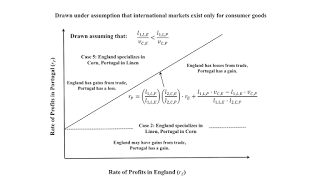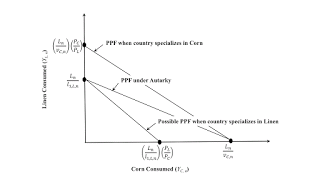Figure 1: Rates Of Profits for Specialization in Consumer Goods1.0 Introduction This post is a continuation of this example. How a country specializes in foreign trade depends on distribution. And foreign trade can reduce the consumption basket to be divided among the inhabitants of a country, as compared with autarky. 2.0 Patterns of Specialization Assume that the consumption basket in both countries contains both corn and linen. In a steady state, international prices and the distribution of income in both countries must be such that at least one country produces each one of the three commodities. Table 1 lists the six possible patterns of specialization in which each commodity is produced in exactly one country. If foreign trade is possible in consumer goods, but not in capital
Topics:
Robert Vienneau considers the following as important: Austrian School Of Economics, Example in Mathematical Economics, international trade
This could be interesting, too:
Robert Vienneau writes Austrian Capital Theory And Triple-Switching In The Corn-Tractor Model
Robert Vienneau writes Double Fluke Cases For Triple-Switching In The Corn-Tractor Model
Robert Vienneau writes The Emergence of Triple Switching and the Rarity of Reswitching Explained
Robert Vienneau writes Recap For A Triple -Switching Example

|
| Figure 1: Rates Of Profits for Specialization in Consumer Goods |
This post is a continuation of this example. How a country specializes in foreign trade depends on distribution. And foreign trade can reduce the consumption basket to be divided among the inhabitants of a country, as compared with autarky.
2.0 Patterns of SpecializationAssume that the consumption basket in both countries contains both corn and linen. In a steady state, international prices and the distribution of income in both countries must be such that at least one country produces each one of the three commodities. Table 1 lists the six possible patterns of specialization in which each commodity is produced in exactly one country. If foreign trade is possible in consumer goods, but not in capital goods, steel must be produced in the same country in which corn is produced. Only cases 2 and 5 are possible. All six cases must be analyzed if foreign trade is possible in both consumer and capital goods.
| Case | England | Portugal |
| 1 | Corn | Linen, Steel |
| 2 | Linen | Corn, Steel |
| 3 | Steel | Corn, Linen |
| 4 | Linen, Steel | Corn |
| 5 | Corn, Steel | Linen |
| 6 | Corn, Linen | Steel |
A pattern of specialization is compatible, given the technology, with certain rates of profits between the trading countries. Under the assumption that financial capital does not flow between countries, the rate of profits may vary between countries. Insofar as the determinants of distribution is unspecified, the model is open. A neoclassical closure would specify intertemporal utility-maximizing consumers in each country
Disequilibrium transitions paths are also not considered here. Firms could find their expectations, with which they have produced or bought capital goods, disappointed. Presumably along such paths, trade might be unbalanced, and exchange rates could vary. Keynesian considerations of effective demand come into play. The elasticities of the demands for imports and exports might be of some importance, as reflected in the Marshall-Lerner conditions. The convergence of such transition paths to steady states does not seem assured.
3.0 Trade in Consumer GoodsConsider the model under the assumption that international markets do not exist for steel. Suppose England specializes in the production of linen, and Portugal specializes in the production of corn, as in case 2. Then the international prices of linen and corn must be related:
l1, L, E/(vC, E + l2, C, ErE) < PL/PC
PL/PC < l1, L, P/(vC, P + l2, C, PrP)
Hence:
l1, L, E/(vC, E + l2, C, ErE) < l1, L, P/(vC, P + l2, C, PrP)
Or:
rP < (l1, L, Pl2, C, ErE + l1, L, PvC, E - l1, L, EvC, P)/(l1, L, El2, C, P)
A specific region in the space for the national rates of profits corresponds to each pattern of specialization. Figure 1, above, shows these two regions, as divided by the upward-sloping line. The figure is drawn under the assumption that England has a comparative advantage in producing linen.
4.0 Production Possibility Frontiers (PPFs)A production possibility frontier (PPF) shows the upper limits on how much linen or corn can be consumed in a given country in a stationary state. Let YC, n represent bushels corn consumed, and let YL, n be the square-yards of linen consumed, where n = E or P for England or Portugal. Let LE and LP be the endowments of labor in England and Portugal, respectively.
I want to consider three PPFs. Here is the PPF for autarky, when a country does not have the possibility to engage in foreign trade:
l1, L, nYL, n + vC, nYC, n = Ln
The PPF for a country specializing in the production of corn is:
vC, n (PL/PC)YL, n + vC, nYC, n = Ln
The PPF for a country specializing in the production of linen is:
l1, L, nYL, n + l1, L, n (PC/PL) YC, n = Ln
Figure 2 graphs these PPFs. The possibility of foreign trade rotates the autarkic PPF, with the pivot on an axis, depending on which product the country specializes in. I have drawn the PPFs such that when the country specializes in the production of linen, it is worse off as a whole. If any corn is consumed at all, foreign trade results in a smaller commodity basket than under autarky.

|
| Figure 2: Production Possibility Frontiers for One Country |
For a country specializing in corn, the ratio of the international price of linen to the international price of corn is bounded above:
PL/PC < l1, L, n/(vC, n + l2, C, nrn)
For a non-negative rate of profits, the right-hand side cannot exceed l1, L, n/vC, n. Hence:
PL/PC < l1, L, n/vC, n
Or:
(Ln/l1, L, n) < (Ln/vC, n)(PC/PL)
The left-hand side is the maximum consumption of linen for this country under autarky. The right-hand side is the corresponding maximum consumption when the country specializes in producing corn. Thus, in this simple model, specialization in corn when no foreign markets in steel exist, unambiguously rotates the PPF outwards. In a comparison of stationary states, foreign trade gives the country specializing in producing corn a greater consumption basket to distribute among its inhabitants.
4.2 Comparison of PPFs for Autarky and Specialization in LinenOn the other hand, specialization in linen could make a country worse off. For the PPF to be rotated inward, one must have:
(Ln/l1, L, n)(PL/PC) < (Ln/vC, n)
Or:
PL/PC < l1, L, n/vC, n
So a country experiences a loss from trade when it specializes in linen and the following condition holds:
l1, L, n/(vC, n + l2, C, nrn) < PL/PC < l1, L, n/vC, n
Notice a loss from trade is not possible when the rate of profits is zero.
Suppose rates of profits and prices are such that England specializes in the production of linen. Prices can be such that England can gain from trade if and only if:
l1, L, E/vC, E < l1, L, P/(vC, P + l2, C, PrP)
Or:
rP < (l1, L, PvC, E - l1, L, EvC, P)/(l1, L, El2, C, P)
The right-hand side can be positive if and only if England has a comparative advantage in producing linen when rates of profits are zero in both countries.
5.0 ConclusionSo in this simple model, when international markets exist in consumer goods, but not in capital goods:
- Which country specializes in producing corn and which in producing linen depends on domestic rates of profits.
- Only one pattern of specialization for a given pair of rates of profits is possible.
- For each pattern of specialization, a pair of rates of profits exists for that specialization.
- If a country specializes in producing corn, its PPF is rotated outwards.
- If a country specializes in producing linen, its PPF may be rotated outwards, but only if:
- The country has a (technologically-defined) comparative advantage in producing linen.
- The relative price of linen on international markets is high enough.
- The PPF may be rotated inwards when a country specializes in producing linen; the terms of trade matter.
I am finding it non-obvious how to complete this analysis when steel can be traded in foreign markets. Also, I should create numerical examples just to confirm my results.
 Heterodox
Heterodox
